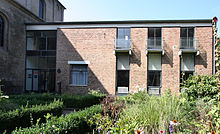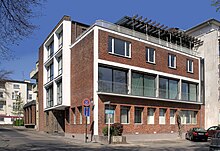Karl Band
Karl Friedrich Heinrich Band (born November 8, 1900 in Cologne ; † October 6, 1995 there ) was a German architect .
origin
Karl Band was the son of the architect Heinrich Band (1855-1919), a long-time employee of the building councilor Hermann Otto Pflaume , whose office he also temporarily headed. He was also related to the painter Michael Welter (1808-1892), who, among other things, painted the Cologne parish church of St. Kunibert after the tower was rebuilt in the 19th century, and to Heinrich Band , the inventor of the bandoneon , a brother of his grandfather.
Band was married to Annegret Band-Löffler and had with her the children Michaela and Gero († 1983), who was his junior partner from 1965. In 1988 he married Gertrud Band-Neyses.
Professional background
Karl Band attended Apostelgymnasium and then studied art history in Bonn (1918–1921) and later architecture in Karlsruhe (1921–1924) with Hermann Billing and Otto Gruber . Since 1919 he was a member of the Catholic student association KDStV Bavaria Bonn . After completing his studies, he worked in various studios in Cologne, such as Hans Schumacher (1925–1927), Heinrich Renard and Eugen Fabricius, before opening his own office in 1928. In September 1929, Band became an employee of the church builder Eduard Endler , and since December 1930 he was his partner. In the same year he also passed the second state examination with subsequent appointment as government master builder. According to an agreement, after Endler's death (1932), his son Clemens was accepted into the studio as a partner (company Band and Endler); but Endler did not continue this partnership after the war and imprisonment.
In the early 1940s, when he was conscripted for military service, Karl Band was commissioned with the planning and execution of accommodations for the V 1 production in Peenemünde and other work. As far as he could, he and like-minded people tried to save the substance of the Romanesque churches in Cologne , which had been destroyed by the war . Shortly after the end of the war, on behalf of the occupying powers, he prepared inventory reports on the condition of the church monuments.
In 1950/1951, Band built his private house next to the St. Kunibert Church . Until 1965 and again from 1983, after the death of his son Gero, Karl Band ran the studio alone, from which the designs for around 140 commercial buildings, 100 residential and commercial buildings and over 100 churches as well as church renovations and reconstructions emerged.
Aftermath
Karl Band died on October 6, 1995 and was buried in the Melaten cemetery (lit.C, between lit.V and lit.W).
Band belonged to a group of artists and architects who are also entitled with the term Cologne School and to which, among others, Rudolf Schwarz , Dominikus Böhm and Gottfried Böhm , Josef Bernard and his former student Hans Schilling belonged.
Karl Band's estate has been processed in the Historical Archive of the City of Cologne since 2007 in order to enable later use for scientific purposes.
In 2014 the green area between Konrad-Adenauer-Ufer and Kunibertsgasse - near his house - was named Karl-Band-Platz.
plant
buildings
Cologne

- 1929: Participation in the renovation of the Rhineland House in Deutz
- 1938–1940: St. Norbert parish church in Dellbrück
- from 1943 (and after 1945): Reconstruction of the St. Marien Hospital building, which was badly damaged in an air raid in 1943
- after 1945: Reconstruction of the Alt St. Heribert Abbey in Deutz
- 1945–1955 / 1968: Reconstruction of the St. Kunibert Church
- 1950: Shop and exhibition building for the Gustav Schirmer furniture store , Cäcilienstr. 25 (canceled in 2007)
- 1950–1951: Residential and commercial building Markmannsgasse 3–5 (with Hans Schilling)
- 1950–1951: Band's house and studio, Kunibertsklostergasse 1 (previously 3)
- 1951: Hohenzollernring 14 office building
- 1951–1952 Catholic parish church “St. Elisabeth ”in Mülheim
- 1951–1954 Catholic parish church “St. Trinity ”in Poll
- 1952–1955: Reconstruction of the Gürzenich (together with Rudolf Schwarz )
- 1952 / 1953–1967 Reconstruction of the Church of St. Gregorius im Elend
- 1953–1955: new crypt and burial chapel for St. Albertus Magnus in St. Andrew's Church
- 1953–1957: Extension for the library and administration of the Museum Schnütgen and reconstruction of the Church of St. Cäcilien , Cäcilienstraße 29
- 1954–1958: Humboldt-Gymnasium , Karthäuserwall 40
- 1954: Dompropstei, Margarethenkloster 5
- 1955: Rectory of the Church of St. Kunibert , Kunibertsklostergasse 2
- 1956: “House of Encounters” of the Catholic men's work, Jabachstrasse 4–8
- 1956–1957: residential and commercial building of Wilhelm Wefers "Paramente Wefers", Komödienstr. 97–103 / castle wall 60
- 1956–1957: Expansion of the church and the construction of the new rectory "Zum Heiligen Geist" in Zollstock
- 1957: Rectory of St. Andreas
- 1960–1972: Reconstruction of the Cologne town hall (with Eugen Weiler, competition 1961, inauguration 1972)
- 1961–1963: Reconstruction of the parish church of St. Johann Baptist
- 1962–1964: New construction of the parish church St. Clemens in Niehl
Outside of Cologne
- 1932: Extension of the St. Mary's Assumption Chapel in Birlinghoven
- 1936/1937: Reconstruction of the St. Nicholas Church in Wipperfürth
- 1936/1937: St. Brictius in Stotzheim
- around 1942: Planning and execution of staff accommodation for the V1 factory in Peenemünde
- 1953–1955: Reconstruction of St. Peter in Zülpich
- 1956: Reconstruction of the St. Johann Baptist Church in ( Hürth -) Kendenich
- 1957: Expansion and reconstruction of the St. Severin Church in Frechen
- 1959–1960: Gelsenkirchen-Hassel, St. Theresia
- 1960–1962: Bonn , Nordstadt , Catholic parish church St. Franziskus (with Werner Fritzen)
- 1963: Expansion of the St. Johann Baptist Church in Refrath
- 1966–1968: Church expansion St. Severin , Hürth - Hermülheim
- 1969: Expansion of the Romanesque church of St. Clemens (Drolshagen) with an extension on the south side.
- 1969–1970: St. John the Evangelist (Cologne-Stammheim) (with Gero Band)
- 1970–1971: Reconstruction and expansion of the Church of St. Mary's Birth in Hürth- Efferen
- 1971–1973 with son Gero (laying of the foundation stone in October 71) Sebastianusstift , nursing home of the St. Dionysius community in Gleuel (now Caritas)
- 1975: Bad Honnef , Rhöndorf district , museum building of the Federal Chancellor Adenauer House Foundation
Competitions
- 1925–1926: Catholic Church in Bickendorf
- 1935: "Old Town Renovation Cologne" (Martinsviertel), first prize
literature
in alphabetical order by authors / editors
- Wolfram Hagspiel : Cologne. Marienburg = city traces, monuments in Cologne 2. JP Bachem, Cologne 1996. ISBN 3-7616-1147-1 , p. 790f., P. 823f.
- Birgit Kastner: The sacred buildings of the Cologne architect Karl Band (1900–1995) = workbook of the Rhenish monument preservation 80th Wernersche Verlagsgesellschaft , Worms 2013. ISBN 978-3-88462-339-8 = Dissertation, Rheinische Friedrich-Wilhelms-Universität Bonn, 2012 .
- Arno M. Lennartz: The architect Eduard Endler 1860-1932 . Dissertation, RWTH Aachen , 1984.
- Hans Schilling: Hans Schilling Architecture 1945–2000 . Walter König, Cologne 2001. ISBN 3-88375-494-3
Individual evidence
- ^ Volume at the NRW Chamber of Architects
- ^ Josef Abt, Johann Ralf Beines, Celia Körber-Leupold: Melaten - Cologne graves and history . Greven, Cologne 1997, ISBN 3-7743-0305-3 , p. 162.
- ↑ Kölner Stadt-Anzeiger from 10./11. May 2014, p. 30
- ^ Ulrich Krings : St. Kunibert war damage and reconstruction. (Colonia Romanica. Yearbook of the Friends of Roman Churches Cologne eV , VII.) Greven Verlag. Cologne 1992. ISSN 0930-8555 . Pp. 50-67.
- ^ Wolfram Hagspiel , Hiltrud Kier : Cologne. Architecture of the 50s . In: City of Cologne (Hrsg.): Stadtspuren - Monuments in Cologne . tape 6 . JP Bachem , Cologne 1986, ISBN 3-7616-0858-6 , p. 267 (With historical photos and new photos by Dorothea Heiermann).
- ^ Wolfram Hagspiel , Hiltrud Kier : Cologne. Architecture of the 50s . In: City of Cologne (Hrsg.): Stadtspuren - Monuments in Cologne . tape 6 . JP Bachem , Cologne 1986, ISBN 3-7616-0858-6 , p. 270 (With historical photos and new photos by Dorothea Heiermann).
- ↑ Angela Pfotenhauer: The Gürzenich and Alt St. Alban . Ed .: City of Cologne. JP Bachem Verlag , Cologne 1993, ISBN 3-7616-1127-7 , p. 64 .
- ^ Wolfram Hagspiel , Hiltrud Kier : Cologne. Architecture of the 50s . In: City of Cologne (Hrsg.): Stadtspuren - Monuments in Cologne . tape 6 . JP Bachem , Cologne 1986, ISBN 3-7616-0858-6 , p. 271 (With historical photos and new photos by Dorothea Heiermann).
- ^ Wolfram Hagspiel , Hiltrud Kier : Cologne. Architecture of the 50s . In: City of Cologne (Hrsg.): Stadtspuren - Monuments in Cologne . tape 6 . JP Bachem , Cologne 1986, ISBN 3-7616-0858-6 , p. 264 (with historical photos and new photos by Dorothea Heiermann).
- ↑ Sign on the church
- ↑ http://www.frechener-geschichtsverein.de/files/veroff/jb2005/d2.pdf ( page no longer available , search in web archives ) Info: The link was automatically marked as defective. Please check the link according to the instructions and then remove this notice. Chronicle of the Frechener Geschichtsverein (PDF document, accessed on August 19, 2013)
- ↑ Handbook of the Archdiocese of Cologne. 26th edition. Bachem Verlag, Cologne 1966. p. 65.
- ↑ Hürther Heimat 28/29 1971 p. 69f
Web links
| personal data | |
|---|---|
| SURNAME | Band, Karl |
| ALTERNATIVE NAMES | Band, Karl Friedrich Heinrich (full name) |
| BRIEF DESCRIPTION | German architect |
| DATE OF BIRTH | November 8, 1900 |
| PLACE OF BIRTH | Cologne |
| DATE OF DEATH | October 6, 1995 |
| Place of death | Cologne |




